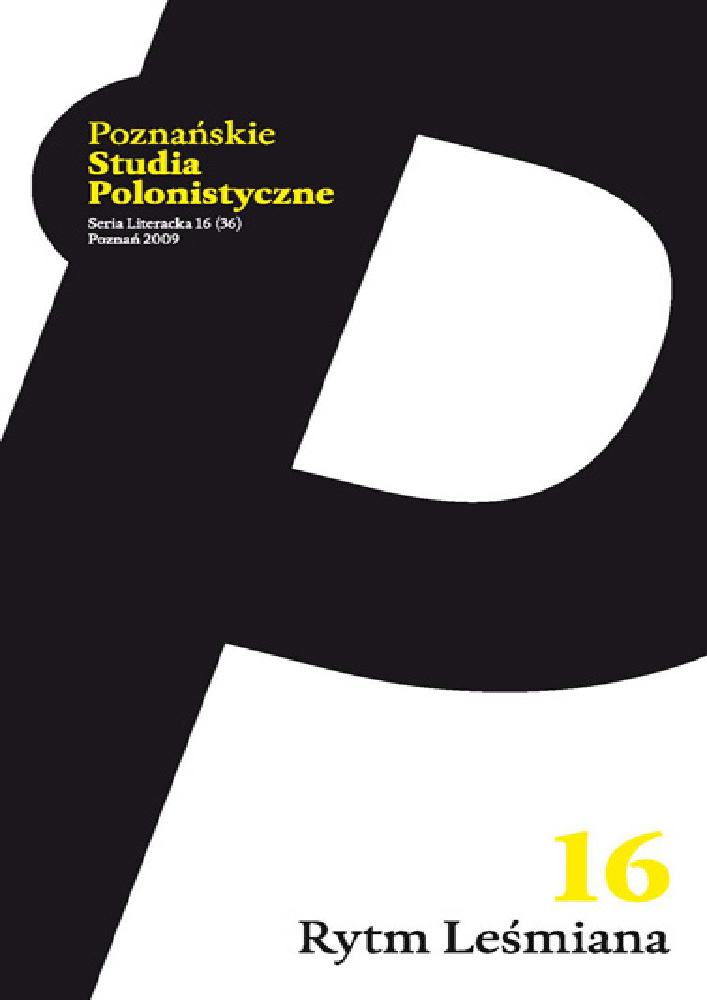Abstract
The article presents B. Leśmian as a poet involved in his self-imposed task of promoting a return to primeval nature, but, at the same time, somebody who is fully aware of the utopian character of thus formulated and adopted assumptions. The two contradictory approaches converge in a poetic figure of desire. This particular urge is treated as a model of the imagination of the poet, who creates his poetical world knowing that the ultimate aim is unattainable but constitutes the ideal of poetry and can only be a state of cognitive assurance and self-knowledge or, alternatively, a situation of ontological stability and fulfilment. However, to reach this utmost goal, either on the poetical plane or on the existentialist, epistemological and ontological plane, to fulfill the cherished desires, is not possible within the poetical world created by Leśmian. The raison d’etre of the self manifested by the protagonists of his poems as well as a justification of this poetry is the very striving towards the goal. The article shows the relevant dimensions of that desire as a metapoetical figure, anthropological and existentialist figures and epistemological and ontological figures. It further presents the opposition and the inner conflict within the modern views of the poet, who, consciously inscribes into his project its impracticability. The distance towards the current times and towards the idealistic assumptions of his own poetical programme constitutes the intrinsic originality of Leśmian’s poems.
References
Bergson H., Ewolucja twórcza, w: idem, Pamięć i życie, przeł. A. Szczepańska, wybór G. Deleuze, Warszawa 2001, s. 99.
Dybel P., Urwane ścieżki: Przybyszewski — Freud — Lacan, Kraków 2000.
Karpowicz T., Poezja niemożliwa. Modele Leśmianowskiej wyobraźni, Wrocław 1975.
Kluba A., Niezrozumiałe — nienazwane — nowoczesne. Leśmian i Iwaszkiewicz — dwa modele poetyckiej niewyrażalności, w: eadem, Autoteliczność — referencyjność — niewyrażalność. O nowoczesnej poezji polskiej (1918-1939), Wrocław 2004.
Leśmian B., Poezje, wybór, wstęp B. Zadura, Lublin 1989.
Leśmian B., Rytm jako światopogląd, w: Pisarze awangardy dwudziestolecia międzywojennego. Autokomentarze (Leśmian — Witkacy — Schulz — Gombrowicz), wybór, oprac. T. Wójcik, Warszawa 1995, s. 42.
Leśmian B., U źródeł rytmu (Studium poetyckie), w: Pisarze awangardy dwudziestolecia międzywojennego. Autokomentarze (Leśmian — Witkacy — Schulz — Gombrowicz), wybór, oprac. T. Wójcik, Warszawa 1995, s. 45.
Leśmian B., Znaczenie pośrednictwa..., w: Pisarze awangardy dwudziestolecia międzywojennego. Autokomentarze (Leśmian — Witkacy — Schulz — Gombrowicz), wybór, oprac. T. Wójcik, Warszawa 1995, s. 22.
Lévinas E., Całość i nieskończoność. Esej o zewnętrzności, przeł. M. Kowalska, wstęp B. Skarga, przekład przejrzał J. Migasiński, Warszawa 1998.
Łapiński Z., Dwaj nowocześni: Leśmian i Przyboś, „Teksty Drugie” 1994, nr 5-6.
Łopuszański P., „Idący z prawdą u warg i u powiek...”. Próba nowego spojrzenia na twórczość Leśmiana, „Teksty Drugie” 2002, nr 6.
Markowski M.P., Leśmian. Poezja i nicość, w: idem, Polska literatura nowoczesna. Leśmian,
Schulz, Witkacy, Kraków 2007.
Nietzsche F., Zmierzch bożyszcz czyli jak filozofuje się młotem, przekł., oprac., posłowie P. Pieniążek, Kraków 2006.
Nycz R., „Słowami... w świat wyglądam”. Bolesława Leśmiana poezja nowoczesna, w: idem, Literatura jako trop rzeczywistości. Poetyka epifanii w nowoczesnej literaturze polskiej, Kraków 2001.
Pragnienie wzbronione? Z Martą Kudelską i Ireneuszem Kanią rozmawia Krzysztof Bielawski, „Mêlée” 2008, nr 2/3, s. 182.
Rowiński C., Człowiek i świat w poezji Leśmiana. Studium filozoficznych koncepcji poety, Warszawa 1982.
Skrendo A., Bolesław Leśmian: „najtrwalszy ze wszystkich przywidzeń i dziwot”, w: idem, Poezja modernizmu. Interpretacje, Kraków 2005.
Sandauer A., Pośmiertny triumf Młodej Polski, w: Z problemów literatury polskiej
XX wieku, t. 1, red. J. Kwiatkowski, Z. Żabicki, Warszawa 1965, s. 477-498.
Śniedziewski P., „Treść, gdy w rytm się stacza”. Leśmian i symbolistyczna fascynacja rytmem, „Pamiętnik Literacki” 2006, z. 3.
Trznadel J., Twórczość Leśmiana (próba przekroju), Warszawa 1964.
Valéry P., Estetyka słowa. Szkice, wybór A. Frybesowa, wstęp M. Żurowski, przeł. D. Eska, A. Frybesowa, Warszawa 1971.
Wyka K., Bolesław Leśmian: dwa utwory („Dusiołek”, „Dziewczyna”), w: Liryka polska. Interpretacje, red. J. Prokop, J. Sławiński, Kraków 1966.
Wyka K., O „Dziewczynie”, w: Poezje Bolesława Leśmiana. Interpretacje, red. B. Stelmaszczyk, T. Cieślak, Kraków 2000, s. 37-38.
Zięba J., Bolesława Leśmiana światopogląd nowoczesny. O eseistyce poety, Kraków 2000.
License
Authors
Authors of texts accepted for publication in „Poznańskie Studia Polonistyczne. Seria Literacka” are required to complete, sign and return to the editor's office the Agreement for granting a royalty-free license to works with a commitment to grant a CC sub-license.
Under the agreement, the authors of texts published in „Poznańskie Studia Polonistyczne. Seria Literacka” grant the Adam Mickiewicz University in Poznań a non-exclusive, royalty-free license and authorize the use of Attribution-NoDerivatives 4.0 International (CC BY-ND 4.0)Creative Commons sub-license.
The authors retain the right to continue the free disposal of the work.
Users
Interested Internet users are entitled to use works published in „Poznańskie Studia Polonistyczne. Seria Literacka” since 2016, for non-commercial purposes only, under the following conditions:
- attribution - obligation to provide, together with the distributed work, information about the authorship, title, source (link to the original work, DOI) and the license itself.
- no derivatives - the work must be preserved in its original form, without the author's consent it is not possible to distribute the modified work, such as translations, publications, etc.
Copyrights are reserved for all texts published before 2016.
Miscellaneous
Adam Mickiewicz University in Poznań retains the right to magazines as a whole (layout, graphic form, title, cover design, logo etc.).
